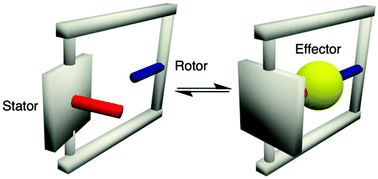Symmetrical or non-symmetrical luminescent turnstiles based on hydroquinone stators and rotors bearing pyridyl or p-dimethylaminopyridyl coordinating units†
Abstract
The design and synthesis of a novel family of molecular turnstiles T1–T5 were achieved. All five turnstiles are based on a stator and a rotor covalently interconnected. While turnstiles T1–T2 are based on a symmetric stator equipped with two coordinating pyridyl units and a rotor bearing either a pyridyl or p-dimethylaminopyridyl coordinating moiety, the two non-symmetric turnstiles T4 and T5 are based on a stator bearing only a single pyridyl unit and the same rotor as T1 and T2 mentioned above. The switching between the open (T1–T5) and the closed (T-M) states of the turnstiles by metal cations (M = Ag+ or Pd2+) was investigated in solution by using 1D and 2D NMR techniques. The locking of the rotational movement leading to the closed state of the turnstile was achieved upon addition of the Ag+ cation through its simultaneous binding by both pyridyl moieties of the stator and the rotor. The unlocking process leading back to the open state was achieved by the addition of Et4NBr. For the symmetric turnstiles T1 and T2, bearing two pyridyl units on the stator, the binding of the Ag+ cation leads to an oscillating phenomenon between the two energetically equivalent closed states. However, in the case of turnstile T1, the oscillating process could be prevented by blocking the rotational movement using PdCl2 as the locking agent. Owing to the emissive nature of the stator, the open and closed states of the turnstiles were investigated by steady state and time-resolved photophysical methods. The photo-excitation of the turnstiles in their open state leads to an intense near-UV to deep-blue emission with short-lived excited states and a singlet intra-ligand charge transfer (1ILCT) character. Upon binding of the Ag+ cation, sizeable bathochromic shifts and a substantial decrease of PLQY were observed. Finally, the coordination of PdCl2, which possesses lower-lying excited states with metal-centered (MC) and ligand-to-metal charge transfer (LMCT) character, completely quenches the photoluminescence.



 Please wait while we load your content...
Please wait while we load your content...